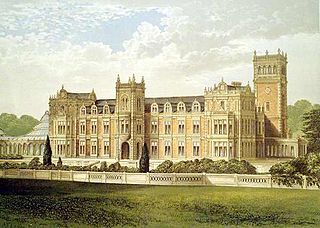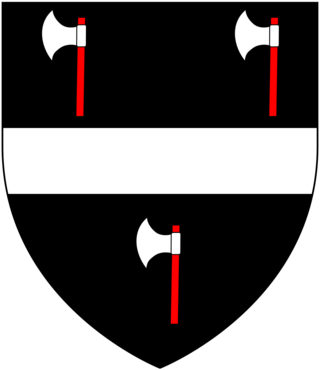
Marquess of Bristol is a title in the Peerage of the United Kingdom held by the Hervey family since 1826. The Marquess's subsidiary titles are Earl of Bristol, Earl Jermyn, of Horningsheath in the County of Suffolk (1826), and Baron Hervey, of Ickworth in the County of Suffolk (1703). The Hervey barony is in the Peerage of England, the earldom of Bristol in the Peerage of Great Britain and the Jermyn earldom in the Peerage of the United Kingdom. Earl Jermyn is used as courtesy title by the Marquess's eldest son and heir. The Marquess of Bristol also holds the office of Hereditary High Steward of the Liberty of St Edmund. The present holder of these titles is Frederick Hervey, the 8th Marquess and 12th Earl of Bristol.

Marquess of Linlithgow, in the County of Linlithgow or West Lothian, is a title in the Peerage of the United Kingdom. It was created on 23 October 1902 for John Hope, 7th Earl of Hopetoun. The current holder of the title is Adrian Hope.

Earl of Gosford is a title in the Peerage of Ireland. It was created in 1806 for Arthur Acheson, 2nd Viscount Gosford.

Earl of Clanwilliam is a title in the Peerage of Ireland. It was created in 1776 for John Meade, 1st Viscount Clanwilliam. The Meade family descends from Sir John Meade, who represented Dublin University and County Tipperary in the Irish House of Commons and served as Attorney-General to James, Duke of York. In 1703, he was created a Baronet, of Ballintubber in the County of Cork, in the Baronetage of Ireland. His eldest son, Pierce, the second Baronet, died unmarried at an early age and was succeeded by his younger brother Richard, the third Baronet. Richard represented Kinsale in the Irish Parliament.

Earl of Stradbroke, in the County of Suffolk, is a title in the Peerage of the United Kingdom. It was created in 1821 for John Rous, 1st Baron Rous, who had earlier represented Suffolk in the House of Commons.

Viscount de Vesci, of Abbeyleix in the Queen's County, now called County Laois, is a title in the Peerage of Ireland. It was created in 1776 for Thomas Vesey, 2nd Baron Knapton and 3rd Baronet. The title Baron Knapton was created in the Peerage of Ireland in 1750 for the first Viscount's father, John Vesey, 2nd Baronet, who had earlier represented Newtownards in the Irish House of Commons. The baronetcy, of Abbeyleix in the Queen's County, was created in the Baronetage of Ireland on 28 September 1698 for the first Baron's father, Reverend Thomas Vesey, Bishop of Killaloe (1713–1714) and Bishop of Ossory (1714–1730).

Baron Faringdon, of Buscot Park in the County of Oxfordshire, is a title in the Peerage of the United Kingdom. It was created in 1916 for Sir Alexander Henderson, 1st Baronet, who had previously represented Stafford West and St George's, Hanover Square in the House of Commons as a Liberal Unionist. He had already been created a baronet in 1902. He was succeeded by his grandson, the second Baron. He was the son of the Hon. Harold Henderson, eldest son of the first Baron, who predeceased his father. Lord Faringdon was a member of the London County Council. As of 2017 the titles are held by his nephew, the third Baron, who succeeded in 1977. He is the son of the Hon. Michael Thomas Handerson, second son of the Hon. Harold Henderson.

Baron Hatherton, of Hatherton in the County of Stafford, is a title in the Peerage of the United Kingdom. It was created in 1835 for the politician Edward Littleton, Chief Secretary for Ireland from 1833 to 1834. Born Edward Walhouse, he assumed in 1812 by Royal licence the surname of Littleton in lieu of his patronymic on succeeding to the estates of his great-uncle Sir Edward Littleton, 4th and last Baronet, of Teddesley Hall. He was also heir to the substantial Walhouse estates and interests, which included Hatherton Hall, near Cannock, then in an exclave of Wolverhampton. His wealth was based upon landed estates centred on Penkridge in southern Staffordshire, mines at Great Wyrley and Bloxwich, quarries and sandpits, brick yards and residential housing, mainly in Walsall.
Baron Joicey, of Chester-le-Street in the County of Durham, is a title in the Peerage of the United Kingdom. It was created in 1906 for the coal mining magnate and former Liberal Member of Parliament for Chester-le-Street, Sir James Joicey, 1st Baronet. He had already been created a baronet, of Longhirst and of Ulgham, both in the County of Northumberland, in the Baronetage of the United Kingdom in 1893. He was succeeded by his eldest son, the second Baron. He was High Sheriff of County Durham in 1910. The second baron lost his son young, and on his death his younger brother succeeded to the barony. The third Baron was an army officer, whose elder son died in WWII without male issue, and he was thus succeeded by his younger son, the fourth baron. As of 2010 the titles are held by the latter's eldest son, the fifth Baron, who succeeded in 1993.

Baron Savile, of Rufford in the County of Nottingham, is a title in the Peerage of the United Kingdom. It was created in 1888 for the diplomat Sir John Savile. He was the eldest of the five illegitimate children of John Lumley-Savile, 8th Earl of Scarbrough, and the grandson of John Lumley-Savile, 7th Earl of Scarbrough. The latter was the fourth of the seven sons of Richard Lumley-Saunderson, 4th Earl of Scarbrough, and his wife Barbara, sister and heiress of the politician Sir George Savile, 8th and last Baronet, of Thornhill, who bequeathed the substantial Savile estates in Yorkshire and Nottinghamshire to his nephew the Hon. Richard Lumley-Saunderson, later 6th Earl of Scarbrough. On his death the estates passed to his younger brother, the aforementioned seventh Earl, and then to his son the eighth Earl. The latter bequeathed the estates to his second natural son Captain Henry Lumley-Savile. When he died they passed to his younger brother Augustus William Lumley-Savile (1829–1887) and then to his eldest brother, the aforementioned John Savile, who was created Baron Savile the following year.

Baron Somerleyton, of Somerleyton in the County of Suffolk, is a title in the Peerage of the United Kingdom. It was created on 26 June 1916 for the Liberal Unionist politician and former Paymaster General Sir Savile Crossley, 2nd Baronet. The titles are currently held by his great-grandson, the fourth Baron, who succeeded his father in 2012.

Baron Phillimore, of Shiplake in the County of Oxford, is a title in the Peerage of the United Kingdom. It was created in 1918 for the former Judge of the High Court of Justice and Lord Justice of Appeal, Sir Walter Phillimore, 2nd Baronet. The Phillimore Baronetcy, of The Coppice, had been created in the Baronetage of the United Kingdom on 28 December 1881 for his father Sir Robert Phillimore, who was also a noted lawyer and judge. The first Baron was succeeded by his son, the second Baron.

Baron Milford is a title that has been created three times, once in the Peerage of Ireland and twice in the Peerage of the United Kingdom. All three creations have been for members of the same family. The first creation came in the Peerage of Ireland in 1776 when Sir Richard Philipps, 7th Baronet, of Picton Castle was made Baron Milford. However, this title became extinct on his death in 1823, while the baronetcy was passed on to a distant relative. The title was revived in the Peerage of the United Kingdom in 1847 when Sir Richard Philipps, 1st Baronet, of Picton Castle was created Baron Milford, of Picton Castle in the County of Pembroke. Born Richard Bulkeley Philipps Grant, he was the son of John Grant and Mary Philippa Artemisia, daughter of James Child and Mary Philippa Artemisia, daughter of Bulkeley Philipps, uncle of the first Baron of the first creation. He succeeded to the Philipps estates in 1823 and assumed the surname of Philipps the same year. In 1828 he was created a Baronet, of Picton Castle in the County of Pembroke, in the Baronetage of the United Kingdom. However, Lord Milford was childless and the titles became extinct on his death in 1857. He devised his estates to his half-brother Reverend James Henry Alexander Gwyther, who assumed the surname of Philipps. James's daughter Mary Philippa married Charles Edward Gregg Fisher, who assumed the surname of Philipps and was created a Baronet, of Picton, in 1887.

Admiral of the Red James Saumarez, 1st Baron de Saumarez, GCB was an admiral of the British Royal Navy, known for his victory at the Second Battle of Algeciras.

The Wrey Baronetcy, of Trebitch in the County of Cornwall, is a title in the Baronetage of England. It was created on 30 June 1628 for William Wrey (d.1636), 2nd son of John Wrey of Trebeigh, St Ive, Cornwall, a member of an ancient Devon family. The third Baronet was a supporter of the Royalist cause and sat as Member of Parliament for Lostwithiel after the Restoration. He married Lady Anne, third daughter and co-heir of Edward Bourchier, 4th Earl of Bath, and a co-heir to the barony of Fitzwarine. The fourth Baronet represented Liskeard and Devon in the House of Commons. The fifth Baronet was Member of Parliament for Camelford while the sixth Baronet represented Barnstaple.
Eric Douglas Saumarez, 7th Baron de Saumarez, is a British hereditary peer.
Baron Dunleath, of Ballywalter in the County of Down, is a title in the Peerage of the United Kingdom. It was created on 29 August 1892 for the businessman and former Conservative Member of Parliament for Downpatrick, John Mulholland. The Mulholland family were involved in the cotton and linen industry in Ulster in the north of Ireland. The first Baron's son, the second Baron, represented Londonderry North in the House of Commons as a Conservative. His grandson, the fourth Baron, was a member of the Northern Ireland Assembly for the Alliance Party. He was succeeded by his first cousin, the fifth Baron, who had already succeeded his father as second Baronet of Ballyscullion. As of 2017 the titles are held by the fifth Baron's son, the sixth Baron, who succeeded in 1997.
Admiral Sir George Nathaniel Broke-Middleton, 3rd Baronet CB was a British Royal Navy officer.
James St Vincent Saumarez, 4th Baron de Saumarez, was a British diplomat and peer, for some forty-five years a member of the House of Lords. The name is pronounced "Sommeray".















